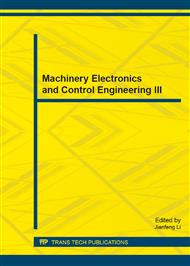With the global environmental deterioration and energy crisis, for its pollution-free, noise-free, mobile simple, would not subject to geographical restrictions such as the unique advantages, solar energy will replace the tradition non-renewable energy. solar water pump system is a photo-mechanic-electronic integration system that is rapidly developed in recent years, which uses electricity from solar cells, through the controller, control the water pump, finally realize the pump operation. in this paper, the research significance, present situation,development direction and the advantages of solar energy will be introduced ,and water pump system use the single chip processor as the core, ultimately to achieve the use of solar energy and complete pumping function. And on the basis of this design, through the system extension and upgrading, with corresponding implementation agencies, can also be applied to industry.
You might also be interested in these eBooks
Info:
© 2014 Trans Tech Publications Ltd. All Rights Reserved
[1]
Chen Yaow-Ming, Lee Chien-Hsing, Wu Hsu-Chin. Calculation of the optimum installation angle for fixed solar-cell panels based on the genetic algorithm and the simulated-annealing method. IEEE Transactions on Energy Conversion 2005, 20(2): 467-73.
DOI: 10.1109/tec.2004.832093
Google Scholar
[2]
Coiante D. and Barra L. Can photovoltaics become an effective energy option,Solar Materials and Solar Cells 1992, 27: 79-89.
DOI: 10.1016/0927-0248(92)90045-q
Google Scholar
[3]
Das Debosmita, Esmaili Reza, Xu Longya, Nichols Dave. An optimal design of a grid connected hybrid wind/photovoltaic/fuel cell system for distributed energy production. In: IECON proceedings (industrial electronics conference); November 2005: 2499-2504.
DOI: 10.1109/iecon.2005.1569298
Google Scholar
[4]
Esram T, C hapm an P L. Comparison of photovoltaic array maximum power point tracking techniques [J]. IEEE Transaction s on Energy Conversion( S0885-8969) , 2007, 22( 2) : 439-449.
DOI: 10.1109/tec.2006.874230
Google Scholar
[5]
Scott Dearborn. Lithium 2iom battery charge: difference and choice of charging system[J]. Global Electronics China, 2008(4): 14-16.
Google Scholar
[6]
Dufo-Lopez Rodolfo, Bernal-Agustin Jose L, Contreras Javier. Optimization of control strategies for stand-alone renewable energy systems with hydrogen storage. Renewable Energy June 2007, 32: 1102-26.
DOI: 10.1016/j.renene.2006.04.013
Google Scholar
[7]
Koutroulis Eftichios, Kolokotsa Dionissia, Potirakis Antonis, Kalaitzakis Kostas. Methodology for optimal sizing of stand-alone photovoltaic/wind-generator systems using genetic algorithms. Solar Energy 2006, 80(9): 1072-88.
DOI: 10.1016/j.solener.2005.11.002
Google Scholar
[8]
Kobayash iK, Takano I, Saw ada Y. A study of a two stage maximum power point tracking control of a photovoltaic system under partially shaded insolation conditions [J]. Solar Energy Materials and Solar Cells (S0927-0248) , 2006, 90.
DOI: 10.1016/j.solmat.2006.06.050
Google Scholar



